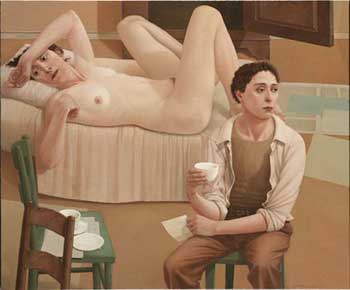
The Figure: Expressionist Classicism
John Graham at Allan Stone Gallery; Alan Feltus at Forum Gallery
By Maureen Mullarkey
AN INCORRIGIBLE RACONTEUR, John Graham (1886-1961) was his own most extravagant story. He inscribed several works with the phrase: “Sum Qui Sum,” the biblical statement of God’s own name: I Am Who Am. Precisely who Graham was evaded even his several wives. One thing is certain: He was a Modernist who found freedom in the confines of the human figure. That contrariness yielded a strangely lyrical and hermetic body of work that is magnificently represented at Allan Stone Gallery.
 |
| Marya, 1944 |
Born Ivan Gratianovich Dombrowski in Kiev, Graham served as a cavalry officer in the Romanov army, earned a law degree and, in 1920, emigrated to New York where he took up painting two years later. Before it became John Graham, his name was rehearsed as often as his personal history, a chronicle of fakery and embellishment.
Graham’s originality is not found in technique but in the uses he made of it and in his ability to synthesize older visual traditions with a Modernist impulse. He extended Moderism’s boundaries to revivify aspects of the Florentine Renaissance, not only its pictorial ones but its struggle to assert the unity of immaterial (in Graham’s case, occult) and physical realms.
Graham was a master at seizing the exceptional characteristics of other artists and reinventing them. A monumental riderless “Horse” (1940) rears on a perspectival floor grid, announcing Paolo Uccello. A column runs behind the head like a carousel pole, anchoring the animal to the picture plane. Uccello’s frontality and restricted modeling suits the probing outlines, unnatural setting and vigorous paint handling of a modern approach:
In painting as in life, Graham took factual information and embroidered it until it became a work of art. “Marya” (1944) is an iconic half-figure portrait derived from a photo of Graham’s first wife and filtered through the relaxed simplifications of Raphael’s portraiture. It is a distillate of Graham’s genius for imitation and exaggeration that results in something inevitable and eternal.
Flesh tone is knifed into canvas to create a smooth substrate for features and shading. Paint density lends an elusive solidity to the surface; delicate stipplings tapped on by fingertips model face and neck. One wrist bears a tidy gash, a variant of the characteristic wound bestowed on his women. It is the wound of the lance in the side of a medieval Man of Sorrows, a graphic symbol suggesting something more subtle than sadism. Besides, Marya herself appears not to mind.
Beautifully nuanced edges and surface effects are carried throughout. Crossed-eyes push suggestions latent in certain figures of Carpaccio and Raphael. Exotic symbols decorate drawings in the manner of Piero della Francesca’s notational studies of perspective, the esoterica of its time. Affinities with early de Kooning appear in the uneasy and anatomically inventive classicism of “Poussin M’Instruit” (1944). (Graham’s pinks might have been lifted off de Kooning’s palette.) One of his first paintings, “Hyacinths” (1922) gives a clue to the exhilarating road he traveled in relatively short time.
Across the courtyard is a series of erotic drawings, all bubble gum on a men’s room wall. Better to have hung the additional paintings that did not fit into the main gallery. Several wonderful late works are left upstairs: "Woman with Dodecahedron" (1959), "Omphale" (1943), and the drawing "Sum Qui Sum” (1952). Visitors should ask to walk up, which they are welcome to do.
Graham was sui generis. To miss this splendid and generous overview of his work, is to miss an influential American master of larger proportions than has yet been fully realized




ALAN FELTUS IS A CONSUMMATE PICTURE MAKER. His pictorial intelligence is undeniable; his luminous command of color, alluring. And yet—. So much loveliness resides in these somnolent figure compositions that my own reservations disappoint me.
 |
| Summer, 2004 |
On view at Forum Gallery are 22 paintings and several pencil drawings. Most are figures in pairs, posed in obeisance to compositional demands rather than narrative ones. Technical accomplishment is flawless. Figural gestures are countered and stabilized by the horizontals and verticals of wall boards and furniture. Even a simple green pencil serves as both a color note and a compositional device. The beauty of those ochres and siennas, pinks and pistachio greens seduces.
But, by now, Mr. Feltus’s formulaic elegance has become a language from which the spirit is in danger of fleeing. Mr. Feltus’s own face appears on each of his detached, deracinated characters. Languid figures nightwalk through their poses, their humanity secondary to their role as emblems of ennui. In “Studio Days” artist and model pose in front of a painting-within-a-painting: a tourist’s view of an unthreatened Italy that exists largely in guide books. The dour-faced woman of “The Green Pencil” (2003) is poised to sketch the landscape, an Umbria of the mind’s eye.
“Cups” (2005) is schematically simple and convincing in mood. A contemporary couple stand side by side holding coffee, eyes fixed off stage. Freed from self-conscious pictorial devices, their staring disaffection communicates itself as personal. “From Page to Memory” (2004-5) conveys a similar reality in the turn of one woman to the other. In both paintings, contrivance gives way to empathy, a quality more rare than expertise and more humane.
Mr. Feltus’s evident expressionist impulses are sealed within a trademark refinement, an artifice that permits him no outlet beyond facial exaggeration or a head bent at an impossible angle—a quirkiness out of joint with the placidity of the whole. Mr. Feltus, living in Assisi, paints in deference to a static past more attractive than the reeling present.




“John Graham: Sum Qui Sum” at Allan Stone Gallery (113 East 90th Street, 212-987-4997).
“Alan Feltus: Silent Dreams” at Forum Gallery (745 Fifth Avenue at 57th Street, 212-355-4545).
This review first appeared in The New York Sun November 3, 2005.
Copyright 2005, Maureen Mullarkey







